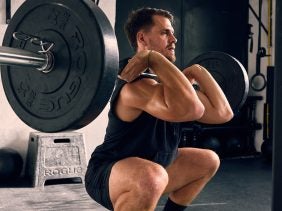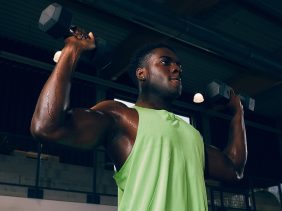Burpees – All about the exercise we love to hate!
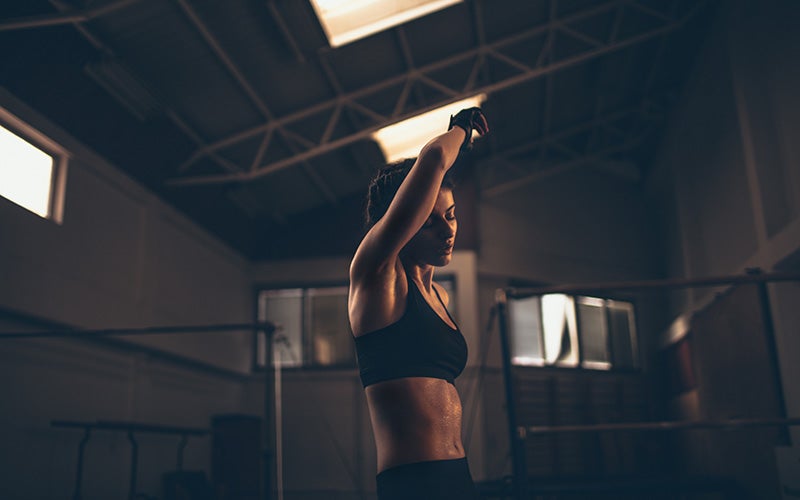 ©AleksandarNakic
©AleksandarNakic
Hardly any other bodyweight exercise can push you to your limit like burpees! Whether you’re a beginner or professional, they are always a challenge and an effective fat burner. We’ll tell you what this versatile workout is all about and how to do it right.
What are burpees?
Nothing brings out that feeling of love-hate like burpees. They’re probably one of the most demanding body weight exercises, but on the upside, that makes them super effective. They use your entire body and can be adapted to any difficulty by using variations or changing the speed, number, or length of breaks between sets. This makes burpees suitable for anyone, from beginners all the way to professional athletes.
A classic burpee combines a push-up, a squat, and a stretch jump into one flowing movement. Here’s how it’s done: Go deep into a squat and place your hands on the floor. Then jump your feet back into a plank position and do a push up. Jump forward again into a squat and jump into the air, stretching your arms upwards with you. That’s it!
Your muscles, as well as your endurance, speed and coordination skills, are put to the test with this complex functional movement – it burns tons of calories. And who do we have to thank for coming up with this burner move?
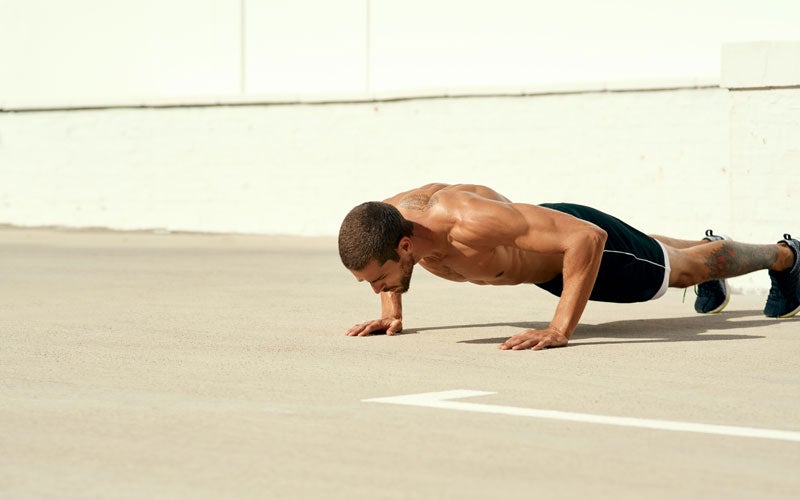
In the 1930s, American physiologist Royal H. Burpee developed a test that was intended to measure the general fitness of an average person. That was the birth of the burpee. The original version, though, was performed without the push-up or stretch jump.
The test subjects would lower themselves into the squat position and place their hands on the floor, jump their feet backwards into a plank, then bring their feet forwards and stand upright again. Burpee only required four reps. He measured the heart rate of the test subjects before and after the quick test, and developed an equation to determine how efficiently the heart pumped blood through the body. He also used the results as a guideline for general fitness.
Later, in the 1940s, the exercise was adopted by the military as a performance test. The soldiers had to do as many burpees as possible in one minute and were rated on their number of reps.
Nowadays, burpees are a popular component of intensive workouts around the globe. Between Crossfit, Freeletics, the Burpees Challenge, and HIIT training – it’s hard to imagine the fitness world without them.
Our Tip: If you’re in the mood for a challenge, try out our workouts! All you need is your own body weight and a mindset to push your own limits.
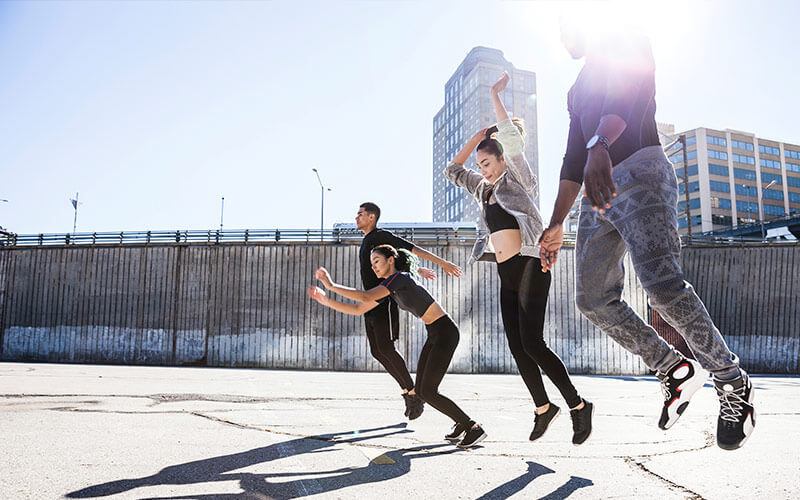
What are burpees good for?
This full-body functional exercise can help you achieve different training goals. The push-up, the plank, and the jump activate a wide range of muscles, engaging your core, chest, triceps, legs and glutes at different stages.
Do you want to lose weight? Make sure burpees are a part of your workout! The all-rounder is an effective fat burner that torches tons of calories. In addition, burpees boost your breathing and heart rate and stimulate your metabolism. When your pulse rate increases rapidly during exercise, your body needs energy to get you back to normal after training. This phenomenon is called the afterburn effect and means that your body will continue to burn calories for hours after your workout.
It’s not only your muscles, either! Burpees also train your cardiovascular system. The motion sequence is complex and includes explosive jumps. Not only will your strength endurance improve, but your speed, agility, coordination, and reflexes will also benefit.
These skills can also be transferred to other exercises such as push-ups or squats, and can improve your overall performance. Because burpees are fast and intense, you’ll also have an easier time sprinting in everyday life (like when you’re running to catch the bus or you have to hurry up the stairs).
As you’ve already read, the burpee was originally designed to test general fitness. Therefore, they are perfect if you just want to keep yourself fit. Since you don’t need any extra equipment, you can do them anywhere and at any time.
Our tip: No matter what your training goal is, a balanced diet will help you reach it. Proteins are the building blocks of your body and are necessary for muscle building, weight loss and general health. Make sure that you always meet your daily protein requirement. If you find it difficult to eat enough protein, our Whey Protein Shakes can help you get there.
Which muscle groups do burpees target?
The multi-purpose burpee combines the push-up, squat, and stretch jump and thus trains your entire body, although some muscles are used more intensively than others. Here’s an overview.
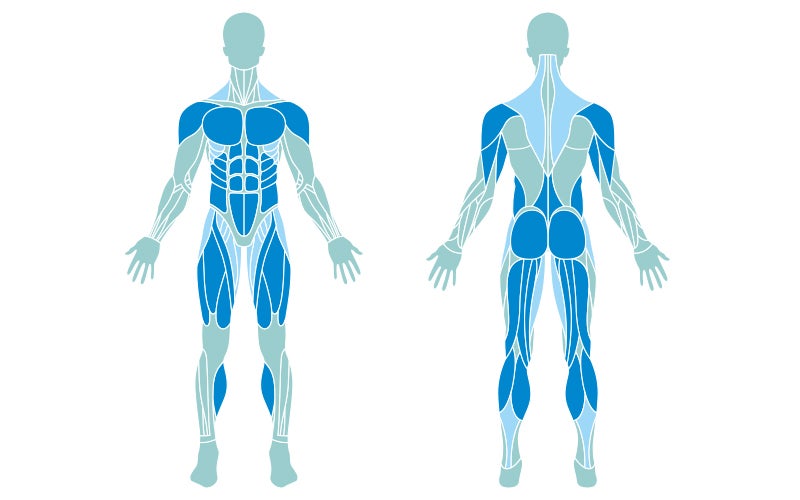
Primary muscles at a glance:
- M. Pectoralis Major and Minor: The small and large pectoral muscles play a central role in push-ups. They’re responsible for the raising and adduction of the arms and push you up during a push up.
- M. Triceps Brachii: Your triceps works closely with the pectoral muscles and are responsible for the extension of the arm. They help push you up during a push up.
- M. Deltoideus Pars Clavicularis: The front part of your shoulder supports the pectoral muscles and triceps when you push up and adduct your arms.
- M. Quadriceps femoris: Your thigh is responsible for extending your leg, so when you stand up from the squat, the quadriceps is actively involved in the movement.
- M. Gluteus Maximus: Your toes point slightly outwards when you perform a squat. This is where the muscles of your backside are involved. The large gluteus muscle also stretches your hips when you stand up from the squat and when you do the stretch jump.
- Hamstrings: The hamstrings include the biceps femoris, semitendinosus and semimembranosus. These muscles are also known as the back of the thighs and are responsible for bending your legs and stretching your hips. They support you when you bend your knees to go deep into a squat and when you stretch your hips on your way up.
- Abdominal muscles: Holding the plank position during a burpee works all your abdominal muscles. This includes the straight, oblique and lateral abdominal muscles that keep you stable during the burpee. Squatting forward also activates your abs.
- M. Erector Spinae: The back extensor is actively involved in the plan position and keeps the spine in an upright position. It also works when you stand up from your squat.
- M. Gastrocnemius: Your calf is actively involved in the stretch jump and is responsible for flexing the foot downwards when you jump up and push off the ground.
Secondary muscles at a glance:
- M. Trapezius: Your trapezius maintains the tension of your plank.
- M. Psoas Major: The hip flexor activates and flexes the hip when crouching forward.
- M. Soleus: Your soleus muscle supports the calf during the stretch jump.
- M. Rhomboidei: The large and small rhomboid muscles pull the shoulder blades back. This allows you to perform a nice deep push-up.
- M. anconeus: This muscle is also called the “elbow muscle” and is located on your forearm. Its function is to stretch your elbow when you bring yourself up from the push-up.
- Adductors: Your adductors are located on the inside of your thigh and their main function is to pull your legs towards your body. They play an important role in the squat and contribute to the hip extension as well as bend the leg in the hip joint.
- Abductors: The abductors spread the legs away from the body and cooperate in squatting and when you jump from the plank to squat and open your legs.
- M. serratus anterior: This runs from the chest to the back and is reminiscent of saw teeth. It helps to rotate your shoulder blade upwards and supports the trapezius muscle in the plank position.
Are burpees healthy?
According to his book, the inventor was not exactly pleased with the military adaptation of burpees for performance testing. The physiologist didn’t want so many repetitions to be done in a row. He felt that this type of exercise was only suitable for people without any cardiovascular issues. He would also not recommend the high number of reps for those who do not have enough strength in their body or for those who are very overweight, since the back is too heavily loaded with weak core muscles and too little body tension1.
As with any exercise, always adjust the intensity to your fitness level. Choose the variation and the number of reps, and challenge yourself but don’t ever take it too far. Proper form should always have priority over numbers. Slow down the tempo if you notice that your form is suffering. Take breaks when you need them.
It’s also very important that you warm up before you start your workout. To prepare your joints for movement and prevent injuries, it is best to do mobility exercises and a few jumping jacks before you start. This will also increase your heart rate so you’re ready to go.

How many calories do burpees burn?
How fit you are and how many repetitions you do in a row, as well as which variation you choose, will affect the number of calories you burn with burpees. Your weight, height and body composition also have an impact. On average, one burpee burns 1.4 calories. This means that for every 10 burpees you do, you burn about 14 calories.
How many burpees a day should you do?
Should you do burpees daily? That depends on your performance level, your health condition, your personal preferences, and your training goals. The same also applies to how many reps you’ll want to do. Make sure to include rest days in your training plan to support your recovery!
It’s generally recommended you do this intense exercise in intervals. Interval training means exercising in short, intense bursts with breaks in between. One good example of this is the Tabata method. This is a HIIT variant which has you alternating 20 seconds of high power exercise with 10-second breaks, and repeats for eight rounds.
Do you want to challenge yourself and reach your limit? Try our 30 day challenge and see how far you can go with our burpees training plan. As a beginner you can start with 3 and improve step by step. Concentrate on the technique, not the speed.
If you’re more experienced, you probably already know your personal max! If not, try the US soldiers’ performance test on yourself to see where you rank. Set a timer for one minute and do as many burpees as you can manage. The US Army requires a minimum of 27. Being able to do 41 is considered excellent.
How to do burpees: beginner and advanced versions
Burpees Beginner Variation
- From standing, come into a deep squat position. Bring your glutes downwards and backwards, keeping your back straight. Firmly place your hands on the floor about shoulder width apart, right beneath your shoulders.
- Tense your body and step your feet back one after the other into a pushup position. Hold your core parallel to the floor.
- Then, step forward with your legs one after the other and stand upright.
Burpees: Basic Version
- Squat from an upright position. Push your glutes down backwards and keep your back straight. Place your palms firmly on the floor about shoulder width apart beneath your shoulders.
- Kick your feet back to the plank position. Keep your legs stretched and your hips in line with your body. In the plank, your body should form a line parallel to the floor.
- Bend your legs slightly, and with momentum push your feet off the floor. Pull your knees under your chest and crouch forward. Shift your weight backwards again and release your palms from the floor.
- Push your legs off the floor and do an extended jump. Your arms will come up. Clap your hands together over or behind your head when jumping up. Land in an upright position.
If you feel like doing more, you can add a push-up from the plank. Half burpees are also a way to get more bang for your buck. The difference is that you don’t come up from the plank right away. After you kick your feet back, stay in the push-up position, jump your feet forward and kick them back again without the push-up.
Common mistakes
- Lack of body tension: It’s tempting to droop your belly down, especially in the plank and when doing the push-up. This can overload your spine. Consciously engage your core to form a straight line with your body! Pay attention to body tension throughout your body to protect your joints from injury.
- Half movements: Some very common burpee mistakes include not stretching your legs back fully, only going halfway down on the push-up, or not making it into the air on the stretch jump. Use your body’s entire range of motion to do the burpee as it’s intended. Make sure to jump all the way back, go deep into the push-up, and put your full power into a controlled, upright jump, making sure your feet leave the ground. If you find this too much of a challenge, slow down your movements or leave out either the push-up or jump until you feel up for it. Either of these options is better than doing the move halfway.
- Hands not properly placed on the floor: Your palm should be completely on the ground just below your shoulders when you go up and down from the plank. This ensures you’re in a stable position and can perform a clean burpee.
- Rounded back when going up and down: Doing burpees quickly can lead to rounding your back. Make sure to keep your back straight when you go into the squat and up again. Tilt your upper body further forward if you are not flexible enough to stay straight. Stick out your chest.
Summary
- Burpees can be adapted to any fitness level
- Because you can change the variation, number, speed, and breaks, beginners as well as experienced and professional athletes will benefit
- A classic burpee is a combination of push-up, squat, and stretch jump
- You can do them anywhere and without any equipment
- This full-body exercise improves your muscle tone, strength endurance, coordination, speed, and general fitness
- Follow our instructions to avoid mistakes and injuries and make sure you have proper form
- Burpees burn calories, have an afterburn effect, and can help you lose weight
- Always make sure you’re doing a clean burpee consistently before you increase the speed or choose a harder variation.
Sources for this article
We at foodspring use only high-quality sources, including peer-reviewed studies, to support the facts within our articles. Read our editorial policy to learn more about how we fact-check and keep our content accurate, reliable, and trustworthy.
- Huffington Post: A brief history of the Burpee. (05.02.2014) https://www.huffpost.com/entry/burpee-history_n_5248575






























